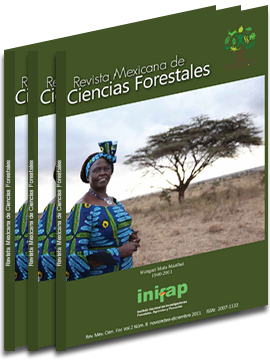MORPHOLOGICAL CHARACTERISTICS OF SEEDLINGS OF TWO TROPICAL FOREST SPECIES PROPAGATED IN BIODEGRADABLE CONTAINERS AND STYROBLOCK TRAYS
DOI:
https://doi.org/10.29298/rmcf.v2i8.542Keywords:
Polystyrene containers, coconut fiber containers, Enterolobium cyclocarpum (Jacq.) Griseb., plants propagation, Tabebuia rosea (Bertol) DC, forest nurseryAbstract
The function of any container for the propagation of forest species is to contain the substrate that supplies roots with water, air, mineral nutrients and provides physical support to the plant while it stays in the nursery. The aim of this study was to assess the technical feasibility of using biodegradable containers (made from coconut fiber) compared with trays of 60 and 77 Styroblock cavities for the propagation of two tropical forest species, Enterolobium cyclocarpum and Tabebuia rosea. A completely randomized design with six treatments and four repetitions was used. After three months in the nursery, the plants of E. cyclocarpum in coconut fiber containers reached a height of 24.8 cm, which was significantly higher (Pr> F = <0.0001) in regard to plants of the same species that were placed into trays of 60 and 77 cavities (14.9 cm). The diameter of the neck of the root of T. rosea and E. cyclocarpum in the first kind of containers showed significant differences (Pr> F = <0.0001), which resulted in two groups (Tukey α = 0.05); the first one, with the largest diameters (6.2 to 5.5 mm) in the two species that were in the biodegradable containers and the second, which includes the trays of 60 and 77 cavities (2.7 to 3.3 mm). In both taxa the total biomass (aerial and root) was higher in coconut fiber containers, although the values obtained in E. cyclocarpum (4.69 g) were significantly higher compared to those of T. rosea (3.66 g). These containers do not pollute, and produce high quality plants.
Downloads
Downloads
Published
How to Cite
Issue
Section
License
The authors who publish in Revista Mexicana de Ciencias Forestales accept the following conditions:
In accordance with copyright laws, Revista Mexicana de Ciencias Forestales recognizes and respects the authors’ moral right and ownership of property rights which will be transferred to the journal for dissemination in open access.
All the texts published by Revista Mexicana de Ciencias Forestales –with no exception– are distributed under a Creative Commons License Attribution-NonCommercial 4.0 International (CC BY-NC 4.0), which allows third parties to use the publication as long as the work’s authorship and its first publication in this journal are mentioned
The author(s) can enter into independent and additional contractual agreements for the nonexclusive distribution of the version of the article published in Revista Mexicana de Ciencias Forestales (for example, include it into an institutional repository or publish it in a book) as long as it is clearly and explicitly indicated that the work was published for the first time in Revista Mexicana de Ciencias Forestales.
For all the above, the authors shall send the form of Letter-transfer of Property Rights for the first publication duly filled in and signed by the author(s). This form must be sent as a PDF file to: ciencia.forestal2@inifap.gob.mx
This work is licensed under a Creative Commons Attribution-Noncommercial 4.0 International license.






